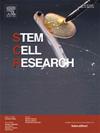从一名 DYT-TOR1A 患者身上生成四种人源 iPSC TorsinA-3xFLAG 报告系
IF 0.8
4区 医学
Q4 BIOTECHNOLOGY & APPLIED MICROBIOLOGY
引用次数: 0
摘要
TOR1A中的3-bp缺失(ΔGAG)是早发孤立性肌张力障碍DYT-TOR1A的常见病因。其确切的发病机制仍不清楚。在这里,我们描述了从一名 DYT-TOR1A 患者身上提取的四个 TorsinA-3xFLAG 报告诱导多能细胞(iPSC)系的生成和特征。这些细胞系携带ΔGAG变体或校正等位基因,以及利用CRISPR/Cas9技术导入的单倍或双倍3xFLAG-Tag。这些细胞为研究 iPSCs、神经祖细胞(smNPC)和神经元中 TorsinA 的内源性 WT 或 ΔE 变体的不同蛋白稳定性、亚细胞定位和相互作用提供了机会。本文章由计算机程序翻译,如有差异,请以英文原文为准。
Generation of four human-derived iPSC TorsinA-3xFLAG reporter lines from a DYT-TOR1A patient
A 3-bp deletion (ΔGAG) in TOR1A is a common cause of early-onset isolated dystonia DYT-TOR1A. The exact disease mechanism remains unknown. Here we describe the generation and characterization of four TorsinA-3xFLAG reporter induced pluripotent cell (iPSC) lines derived from a DYT-TOR1A patient. The cell lines carry either a ΔGAG variant or a corrected allele and a mono- or biallelic 3xFLAG-Tag introduced using CRISPR/Cas9 technology. These cells provide an opportunity to study differential protein stability, subcellular localization, and interactors of endogenous WT or ΔE variants of TorsinA in iPSCs, neural progenitor cells (smNPC), and neurons.
求助全文
通过发布文献求助,成功后即可免费获取论文全文。
去求助
来源期刊

Stem cell research
生物-生物工程与应用微生物
CiteScore
2.20
自引率
8.30%
发文量
338
审稿时长
55 days
期刊介绍:
Stem Cell Research is dedicated to publishing high-quality manuscripts focusing on the biology and applications of stem cell research. Submissions to Stem Cell Research, may cover all aspects of stem cells, including embryonic stem cells, tissue-specific stem cells, cancer stem cells, developmental studies, stem cell genomes, and translational research. Stem Cell Research publishes 6 issues a year.
 求助内容:
求助内容: 应助结果提醒方式:
应助结果提醒方式:


